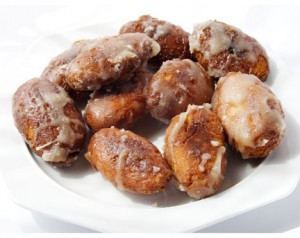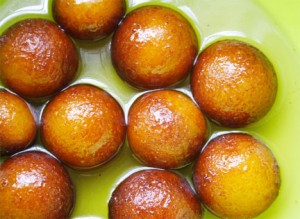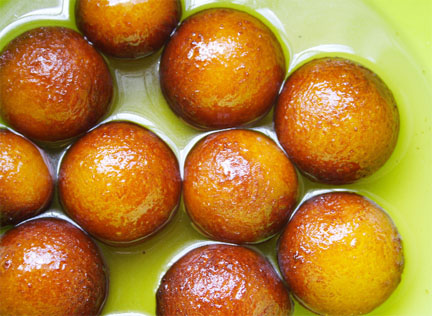Tastes Like Home
Hi Everyone,
Gulab Jamoon – that’s what was giving me all the pain in the kitchen two weeks ago. To quickly recap – In last week’s column I wrote about using two recipes. These recipes had frustrated my efforts to make Gulab Jamoon and ultimately led to confusion, frustration and anger in the kitchen.

Gulab Jamun, meet Gulab Jamoon. More correctly, I should say, Indian Gulab Jamun meet Indo-Caribbean Gulab Jamoon. The difference lies not just in the slight variation of the spelling of the word – Jamun/Jamoon – but also in the ingredients, method of preparation, shape, texture and appearance. Let me hasten to add that it was not the Indian Gulab Jamun that was difficult to make. Actually, I got that right on the first attempt! It was the Indo-Caribbean Gulab Jamoon that caused all the stress.
I’m not going to rehash all that I went through, read last week’s column for that.
I read where a Trinidadian friend of mine described our (Caribbean) Gulab Jamoon as, “One sweet to rule them all!” If you know anything of Tolkien’s Lord of the Rings, you will understand what a powerful statement this is. At every religious festival, Pooja/Jhandi, wedding or other special occasion I have attended, and celebrated with my extended family and friends, one thing I always looked forward to was Gulab Jamoon. It’s sweet, deep-fried pastry dough that is then coated in sugar syrup that crystallizes. Need I say more? Need I explain why it rules? Need I explain the lure? No, it is not necessary.

The first time I had Indian Gulab Jamun was at an Indian restaurant in the United States of America. I was intrigued immediately because I knew that we have Gulab Jamoon but it looked nothing like the large syrup-soaked ball set in front of me. I chalked it up to yet one of those many foods that were adapted having travelled. I pulled the small white bowl closer to me and admired the Gulab Jamun. It was perfectly round, evenly browned all around and smooth. I took my spoon and cut into it, sweet, cardamom-rose-water scented and flavoured syrup lazily falling to the sides as the spoon cut into it. I put the spoon into my mouth, already intoxicated from the cardamom. In a split second my eyes flew open and closed and then I slid down comfortably in my chair. Oh, what sweet heaven is this, I wondered. There was no need for a lot of chewing, I gently rubbed the Gulab Jamun with my tongue against the roof of my mouth and swallowed slowly. I wanted the taste to last forever. Each spoonful brought new waves of pleasure. I heard one of my friends sitting next to me also groan with pleasure from eating her Gulab Jamun. When I was done, I wanted more Gulab Jamun but I held myself back only because I knew that to do so would be wrong on so many levels and so I restrained myself.
My friend asked our server what the Gulab Jamun was made with but he was rather guarded and vague. I rushed home and onto the internet to find out more – milk powder, flour, ghee or butter, baking soda, and milk. The ingredients are made into a dough, rolled into smooth balls and deep-fried at a low temperature and then are placed into a luxurious bath of cardamom and rose-water syrup with the option of a few strands of saffron thread. The balls are allowed to soak for hours until they become heavily pregnant with the syrup. It is only then that they are ready for eating.
The Indo-Caribbean Gulab Jamoon is made with flour, butter, condensed milk, whole milk, and ground cardamom. Everything is kneaded to a smooth dough, made into almond shapes and deep fried on medium heat until cooked through and browned all over. The fried dough is then tossed with a thick syrup that crystallizes as the Gulab Jamoon is tossed in it. The grief ours gave me was that the recipes were not accurate on the butter to flour ratio or butter temperature.
As I said last week, I think that what I figured out on my own for our Caribbean Gulab Jamoon was pretty decent as you can see from the photograph and the tasters ate them out in no time. I’m excited to get to Guyana or Trinidad though and actually sit and watch someone make it and get the right measurements of ingredients. I never saw how my Aunt Betty made it because the adults would have been busy in the kitchen and a kid would have just gotten in the way.
I encourage you to try making the Indian Gulab Jamun just because it is different from ours and it is another way to expand your palette; I know that you’d enjoy it very much. Here are some things for you to note before attempting the recipe.
● Moisten your hands with a little oil to better handle the dough when rolling the balls
● Adding too much baking soda will cause the balls to burst when frying
● The dough must be cooked on a low to medium heat so that it is cooked through right to the centre and uniformly browned
● It is important to let the balls rest for at least 5 minutes before adding them to the syrup
● The syrup should be warm when you add the balls to it. You may have to reheat it gently if it gets cool before the balls are added
● Turn the balls in the syrup intermittently to ensure that the syrup is absorbed all over
● One of the main criteria for excellent Gulab Jamun is to ensure that there are no cracks, hence the importance of rolling the balls smoothly, not adding too much baking soda and resting them before adding it to the syrup
Gulab Jamun
(Adapted from Manjula’s Kitchen)
Yield: 10 – 14
INGREDIENTS
Syrup:
1½ cups water
1½ cups granulated white sugar
5 green cardamom pods lightly bruised
½ teaspoon rose essence
A couple strands of saffron (optional)
Balls:
1 cup skim-milk powder
¼ cup all-purpose flour
1/8 teaspoon baking soda (a pinch)
3 tablespoons unsalted butter at room temperature
¼ cup whole milk, room temperature
EQUIPMENT
1 medium saucepan
1 large spoon
2 medium bowls
1 large plate or tray
1 deep frying pan
1 slotted spoon
Paper towels
METHOD
Syrup:
Add all the ingredients to saucepan and bring to a boil, let boil for 1 – 2 minutes and set aside to remain warm.
Balls:
1. Add milk powder, flour and baking soda to bowl and mix thoroughly. Rub in butter
2. Add milk to make a soft-sticky dough. Let rest for 1 – 2 minutes (depending on the temperature of the day, it might not be necessary to let the dough rest as it tends to dry out quickly. If you find as you are working with it to form the balls that it is a getting dry, just add a little milk to moisten it)
3. Divide dough into equal parts and roll each piece between the palms of your hands to make smooth balls. There should be no cracks!
4. Heat oil over medium-low heat and fry the balls in batches; once added let them rise naturally and then move them around constantly to ensure that they are evenly browned and cooked. Cooking time should be about 5 – 7 minutes. Drain on paper towels and let rest and continue to fry the balls. When the second batch is finished cooking, you can add the first batch to the syrup and continue this process until all the balls have been added to the syrup
5. Let the balls rest in the syrup for at least 3 hours before serving. The longer the Gulab Jamun soak in the syrup, the better
6. Serve with a drizzle of the syrup.

